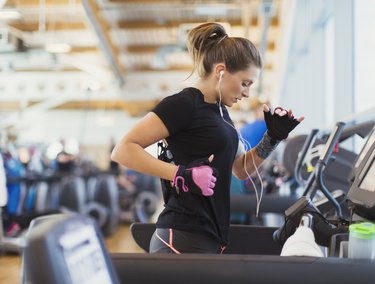
Carbs are found in all foods except meat, including grains, fruits, vegetables and even dairy. Regardless of the source, after absorption, carbs exist in the body as glucose. Glucose is the body's first and often preferred energy source.
When you consume more carbs, or energy, than your body needs, the excess glucose is stored in your liver and muscles as glycogen. To burn carbs you must use available glucose, and then deplete glycogen stores.
Video of the Day
Video of the Day
Tip
Your body burns carbs as its preferred source of energy during exercise.
Skip the Preworkout Meal
When you exercise, your body uses available glucose to provide energy. If you have just eaten a meal or had a preworkout drink, this is first used to fuel your body. If you want to burn the carbs already stored in your body, do not take in excess carbs before or during your workout.
Avoiding pre-exercise carbs may reduce the level at which you are able to perform and may cause you to become tired sooner. But if you keep providing fuel for your body, your body will never use the fuel it has stored.
High-Intensity Cardio
Once available glucose is used, your body converts stored glucose, called glycogen, back into its usable form. How soon this occurs depends on your exercise intensity.
High-intensity exercise, such as intervals, burns stored carbs sooner. To perform intervals, warm up on your preferred cardio machine or by jogging outdoors. Then sprint, pedal or row as fast as you can for 30 seconds. Follow this with two minutes of active rest at warm-up speed. Repeat this cycle eight times for a short, carb-burning workout.
Other options for intense cardio include group fitness classes like Zumba or cycling classes focusing on sprints or climbing hills.
Read more: How to Burn Carbs Fast
Circuit-Training Exercise
Resistance training, specifically circuit training, is a form of anaerobic exercise designed to use up glucose and deplete glycogen stores. During anaerobic exercise, a process called glycolysis uses glucose to produce energy.
To target this source of energy, perform an exercise circuit consisting of one exercise for each muscle group — chest, back, shoulders, biceps, triceps and legs. Do 20 repetitions of each exercise, performing one right after the other with no rest in between. When you complete one circuit, rest for two minutes. Repeat the entire circuit once or twice more.
Precautions and Considerations
Carbs are necessary; the brain prefers glucose to other forms of energy. The Dietary Guidelines for Americans, 2015-2020, suggests including whole fruits, vegetables and whole grains as healthy carbohydrate choices in your diet.
A low-carb diet may lead to ketosis, a state your body may enter if forced to create energy from sources other than glucose. Ketosis can cause dehydration and blood-related issues. Without carbs, the body breaks down proteins, found in muscle, for energy. Muscles, or lean body mass, help burn fat through creating an elevated metabolic rate. The body also requires a certain amount of carbs to process the breakdown of fat.
Read more: Fat Burning Vs. Carbohydrate Burning